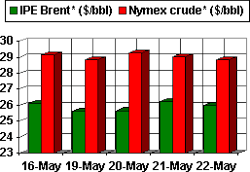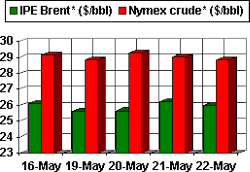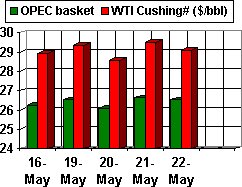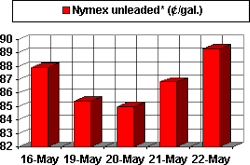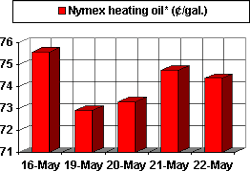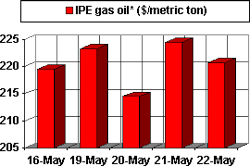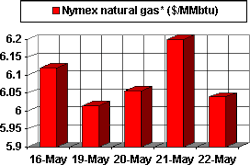For some weeks now, there have concerns of too much oil coming onto the market. This line of thinking presumes that unless the Organization of Petroleum Exporting Countries initiates a production cut at its June meeting, oil prices will plunge.
Even the president of OPEC, Hamad al-Attiyah, chimed in, suggesting that cuts at the Doha meeting were inevitable and that the only question was by how much.
That apparent consensus is eroding. And there is not one culprit but several.
Market Hotline last focused on the return of an oil price risk premium, in the form of perceived risk to Saudi oil facilities, in the wake of the terrorist attacks in linchpin supplier Saudi Arabia (OGJ Online, May 16, 2003). This week's focus is on the wild cards that represent other potential supply constraints that could eliminate the need for OPEC to do anything at Doha on June 11.
Continuing Iraqi threat
Foremost in any discussion of second half oil supply is the question over the return of Iraqi supply to the market.
In the wake of winning a May 22 United Nations Security Council vote allowing a lifting of sanctions and the resumption of oil sales under a coalition aegis, some US officials suggested that Iraqi exports could resume as soon as early June.
While resumption of Iraqi oil sales in June is a reasonable prospect, it likely would entail the 9 million bbl of crude still stored at Ceyhan since just before the war erupted. That will quickly bring in some needed hard currency to help pay for reconstruction efforts. But what about oil sales thereafter? At last report, Iraq was producing a little over 300,000 b/d of oil. That's not enough to accommodate even local refining needs, and so Iraqis must still import refined products from Persian Gulf neighbors for the time being.
There is reason to believe that the ramp-up back to 2 million b/d will be more problematic than previously believed. There is emerging within Iraq the disquieting picture of an organized effort by ousted Baathist remnants and perhaps by some among the more-radical Iraqi Shiite groups to disrupt oil field operations. There are reports out of Iraq that ordnance recently removed from around oil wells is being surreptitiously replaced by new ordnance. Is it possible that Saddam Hussein is still not only alive but perhaps had planned all along to be spirited out of harm's way during the war? Is there a viable Saddam-legacy network with the intent of conducting a campaign to subvert the coalition's goals and ultimately return to power? Far-fetched? Perhaps, but name another despot in recent memory who was so skilled at survival.
The chaos seems to be attenuated rather than relieved as looting and sabotage of equipment and persistent security threats to personnel continue. The US's "de-Baathification" initiative will eliminate some of that but exacerbate other problems as many of the Iraqi oil sector's managers and technocrats were Baathists and may be difficult to replace.
And so it begins to look like months, not weeks, before Iraqi supplies beyond Ceyhan's stockpile reach world oil markets. The best guess by some US officials now is September before prewar volumes are regainedand that assumes that the Saddam-legacy troublemakers don't get even more out of hand.
Other concerns
Meanwhile, the likelihood grows of worsening hostilities in Indonesia's breakaway Aceh Province. While Aceh is more important for its LNG output than its oil output, disruptions to Asian LNG supplies could spawn a sudden pull on fuel oil by dual-fuel-capable LNG buyers in Japan, Taiwan, and South Korea.
Nigerian crude output remains disrupted by civil unrest, with the outage at last report 200,000 b/d.
There are reports that the administration of Venezuelan Hugo Chavez is steamrollering other businesses in Venezuela if they don't line up in lockstep with the new regime at Petroleos de Venezuela S. This augurs for more foment in the months running up to the August referendum on Chavez's recall.
The latest US oil inventory reports are hardly reassuring, at levels nearly 50 million bbl below the preceding 5 year averageeven at a time when US oil imports are rocketing, which normally coincides with a strong inventory build.
There are reports of the Saudis reducing liftings, suggesting a preemptive bid at reducing supply at the Doha meeting.
That last item may prove to be a self-fulfilling prophecy.
A smart bet now might be on OPEC at Doha simply affirming its March decision in Vienna.
(Author's e-mail: [email protected])
OGJ Hotline Market Pulse
Latest Prices as of May 23, 2003
IPE BRENT/NYMEX CRUDE
null
OPEC BASKET/WTI SPOT
null
NYMEX UNLEADED
null
NYMEX HEATING OIL
null
IPE GAS OIL
null
NYMEX NATURAL GAS
null
NOTE: Because of holidays, lack of data availability, or rescheduling of chart publication, prices shown may not always reflect the immediate preceding 5 days.
*Futures price, next month delivery. #Spot price. @New contract
